2021年仁爱版中考英语一轮复习课件:七上 Unit 1(46张PPT)
文档属性
| 名称 | 2021年仁爱版中考英语一轮复习课件:七上 Unit 1(46张PPT) | 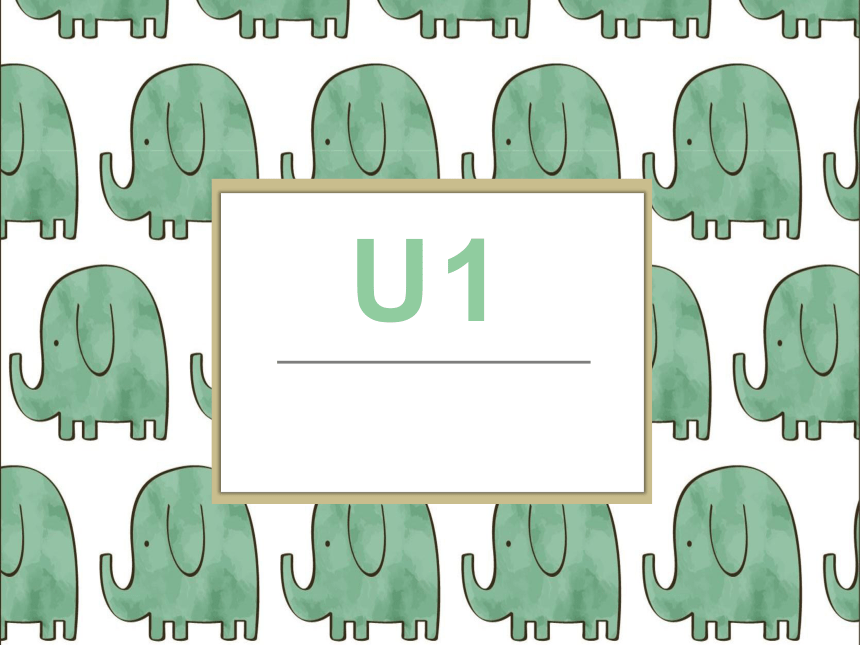 | |
| 格式 | pptx | ||
| 文件大小 | 14.1MB | ||
| 资源类型 | 教案 | ||
| 版本资源 | 仁爱科普版 | ||
| 科目 | 英语 | ||
| 更新时间 | 2021-04-15 07:20:34 | ||
图片预览

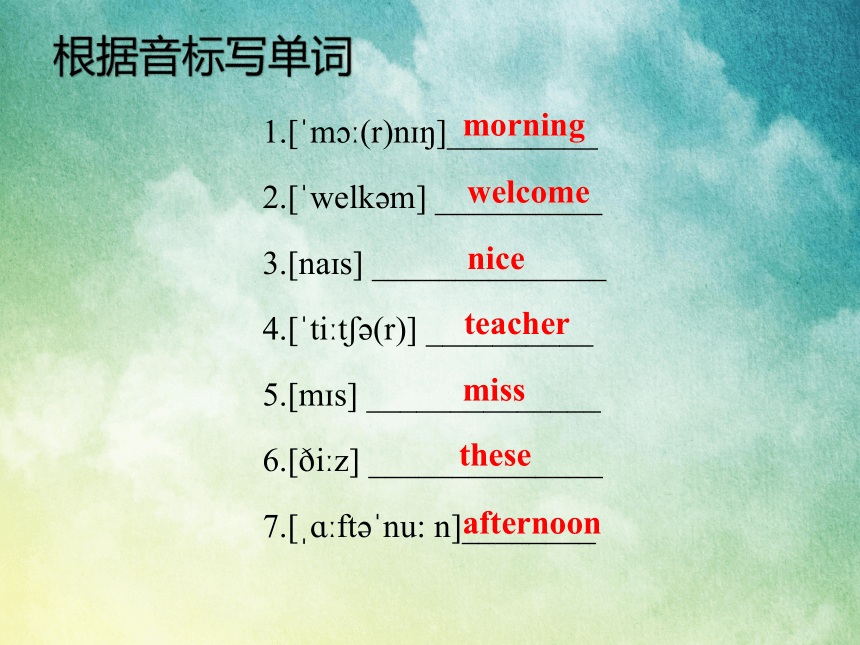

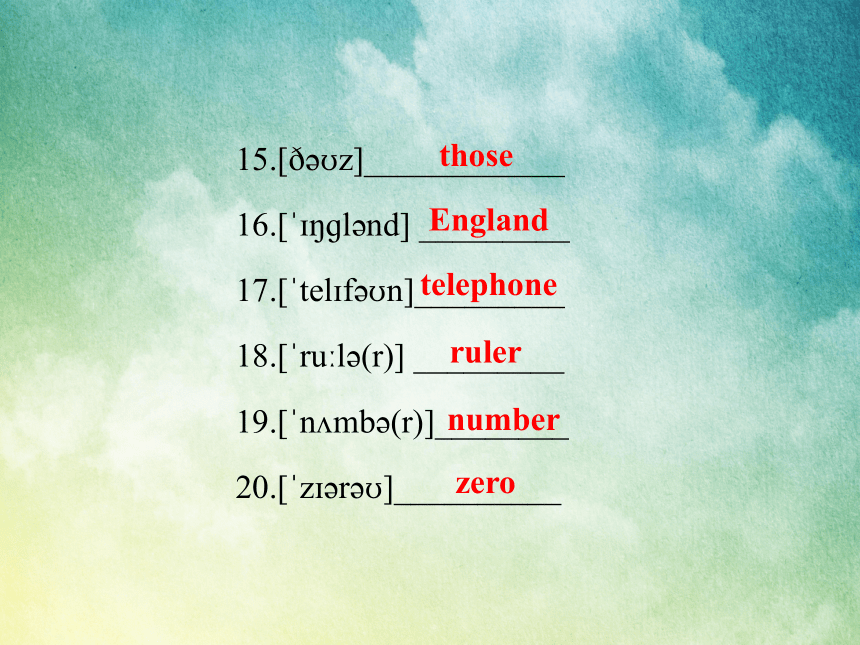
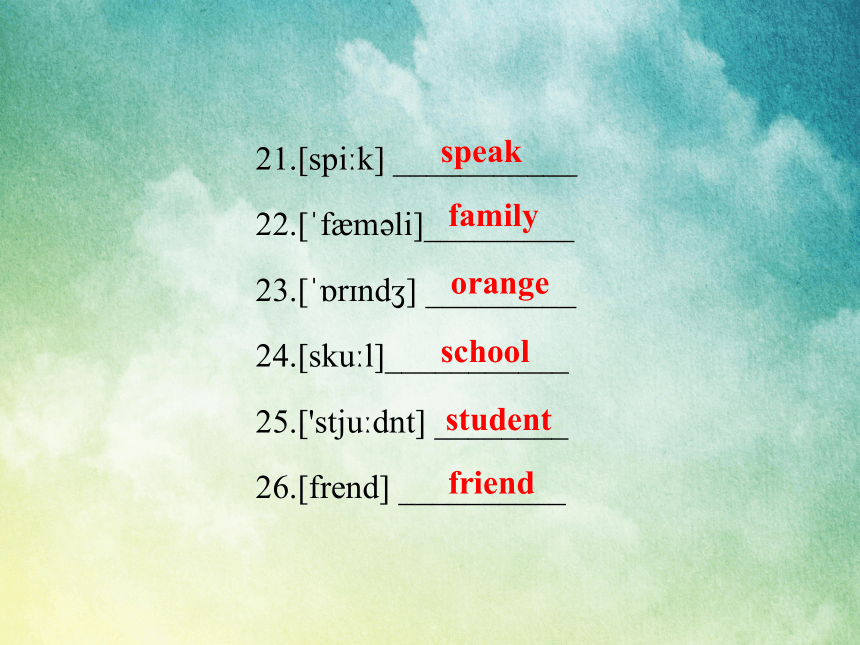

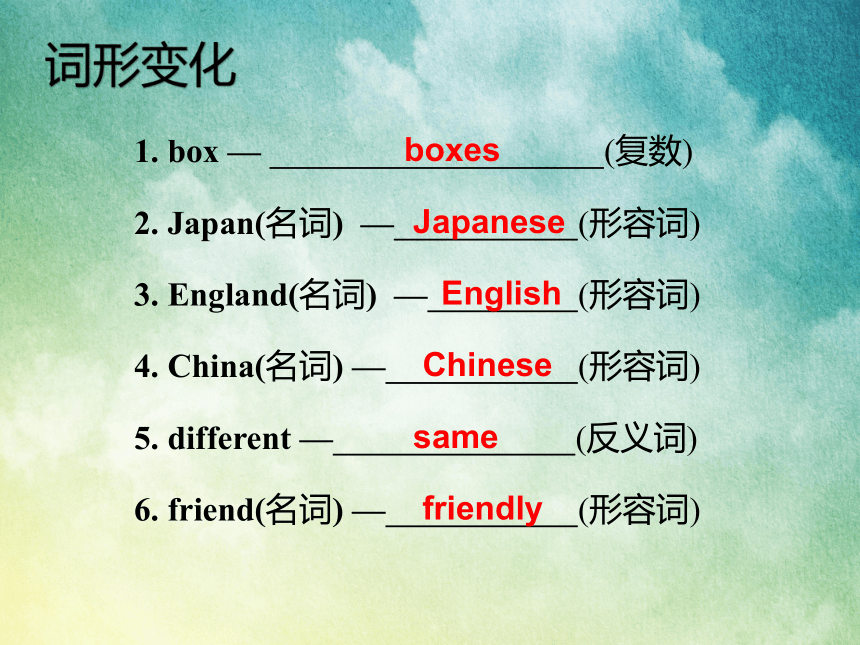
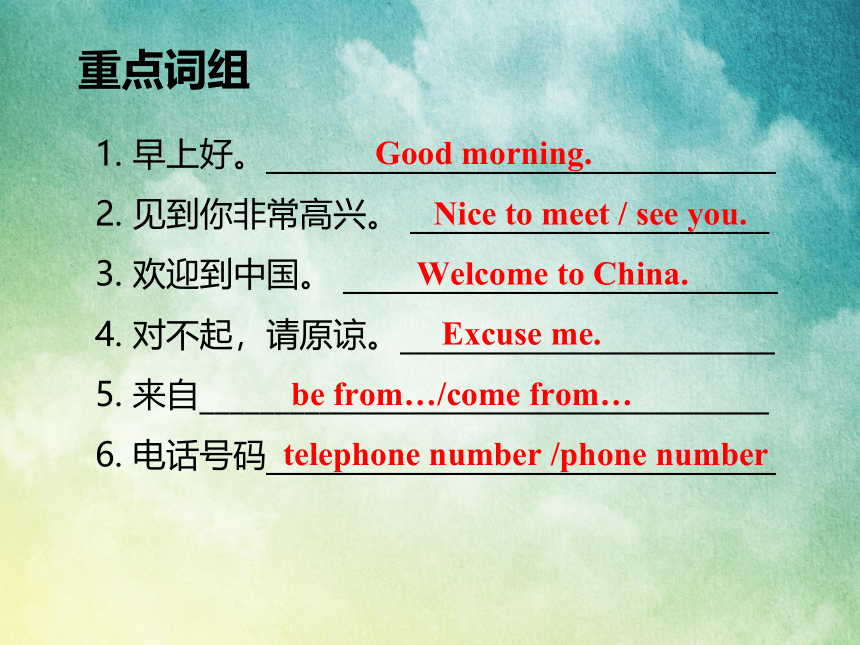
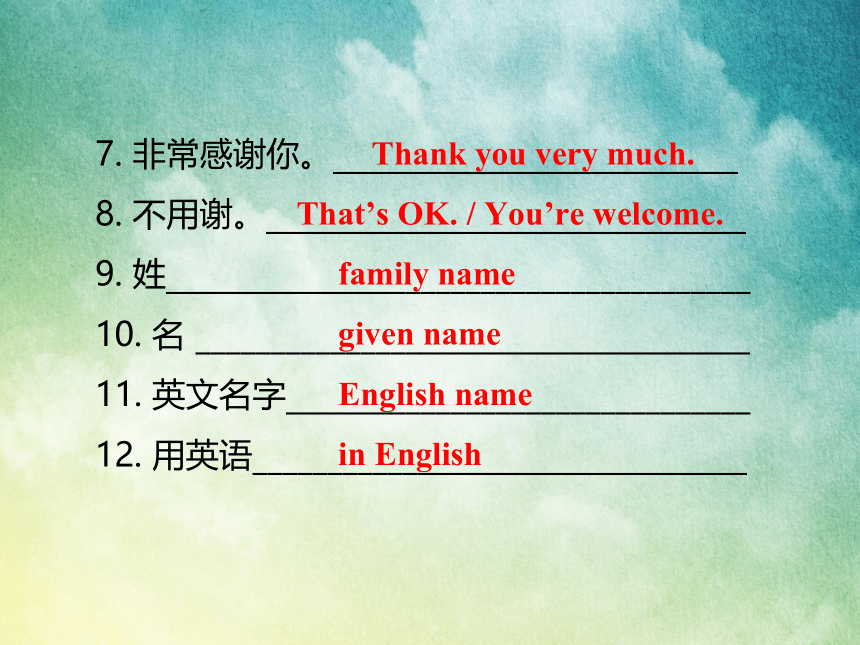
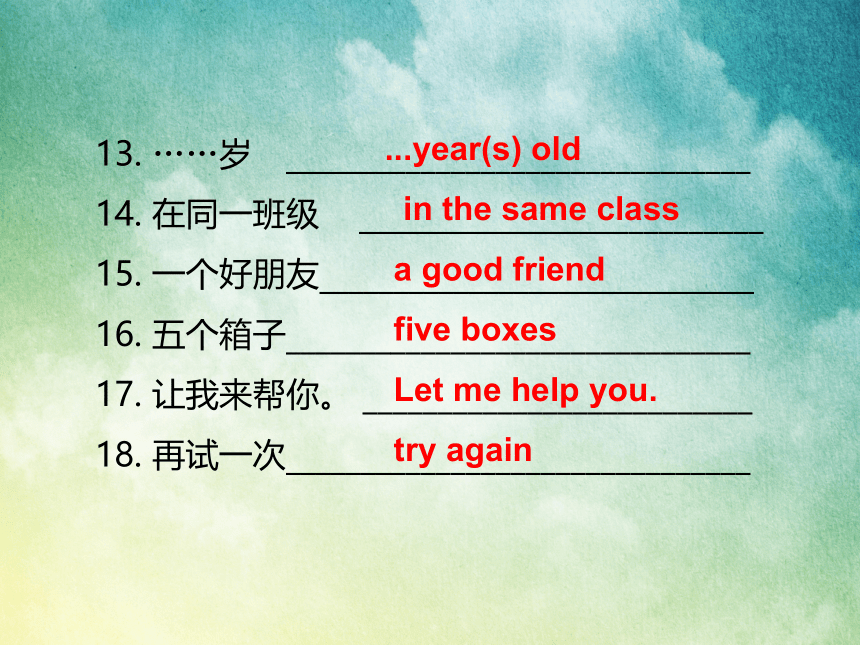
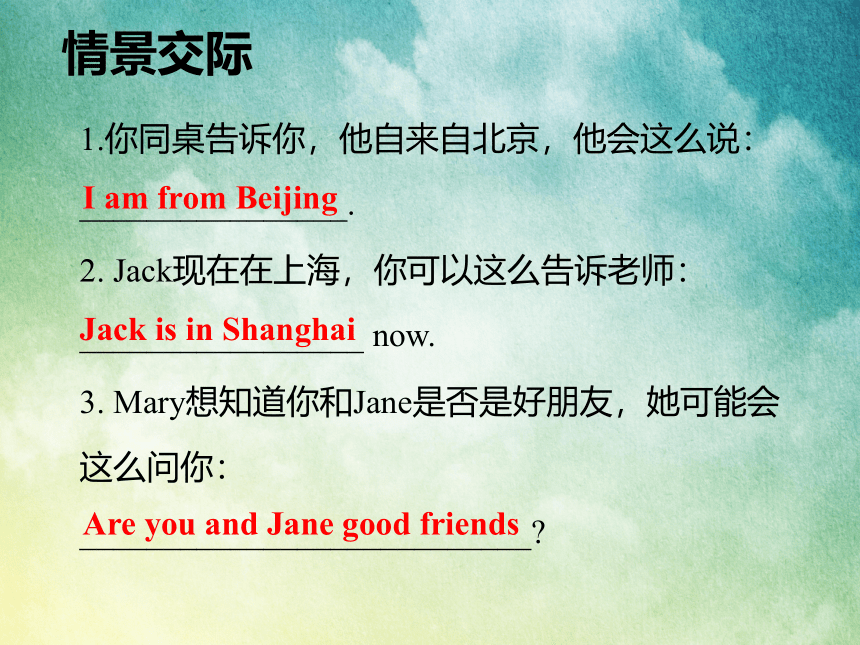
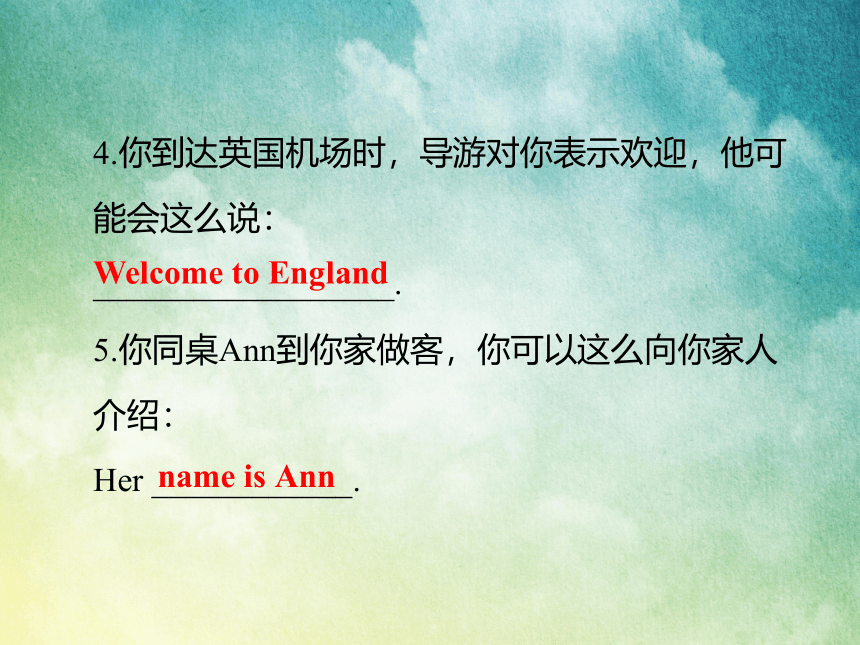
文档简介
U1
1.[?m??(r)n??]_________
2.[?welk?m]?__________
3.[na?s]?______________
4.[?ti?t??(r)]?__________
5.[m?s]?______________
6.[?i?z]?______________
7.[?ɑ?ft??nu: n]________
morning
welcome
nice
teacher
miss
these
afternoon
根据音标写单词
8.[?ɡ?d'ba?]_________
9.[help]?____________
10.[?k?skju?z]________
11.[?k?n?d?]?________?
12.[?'ɡen]?___________
13.[??mer?k?]?________
14.[d???p?n]?________
goodbye
help
excuse
Canada
again
America
Japan
15.[???z]____________
16.[???ɡl?nd]?_________
17.[?tel?f??n]_________
18.[?ru?l?(r)]?_________
19.[?n?mb?(r)]________
20.[?z??r??]__________
those
England
telephone
ruler
number
zero
21.[spi?k]?___________
22.[?f?m?li]_________
23.[??r?nd?]?_________
24.[sku?l]___________
25.['stju?dnt]?________??
26.[frend]?__________
speak
family
orange
school
student
friend
根据英文单词写出中文意思
1.the United States ?
2.the United Kingdom ?
3.thanks ?
4.international ?
5.junior ?
6.blond ?
7.snowman ?
8.Cuba ?
9.pants ?
10.theirs ?
美国
英国
谢谢
国际的
初级的
金黄色的
雪人
古巴
裤子
他/她/它们的
box?— (复数)?
2. Japan(名词)??— (形容词)??
3. England(名词)??— (形容词)?
4. China(名词) — (形容词)???
5. different — (反义词)
6. friend(名词) — (形容词)
boxes
Japanese
English
Chinese
same
friendly
词形变化
1. 早上好。__________________________________
2. 见到你非常高兴。 ________________________
3. 欢迎到中国。 _____________________________ 4. 对不起,请原谅。_________________________
5. 来自______________________________________
6. 电话号码__________________________________
Good morning.
Nice to meet / see you.
Welcome to China.
Excuse me.
?be from…/come from…???? ???
telephone number /phone number
重点词组
7. 非常感谢你。___________________________
8. 不用谢。________________________________
9. 姓_______________________________________
10. 名 _____________________________________?
11. 英文名字_______________________________ ?
12. 用英语_________________________________
Thank you very much.
That’s OK. / You’re welcome.
family name????
??? given name?? ?
English name ???? ??? ? ? ? ?
in English
13. ……岁 _______________________________
14. 在同一班级????___________________________
15. 一个好朋友_____________________________
16. 五个箱子_______________________________
17. 让我来帮你。?__________________________
18. 再试一次_______________________________
...year(s) old
in the same class??? ?
a good friend
five boxes
Let me help you.
try again
1.你同桌告诉你,他自来自北京,他会这么说:
________________.
2. Jack现在在上海,你可以这么告诉老师:
_________________ now.
3. Mary想知道你和Jane是否是好朋友,她可能会这么问你:
___________________________?
I am from Beijing
Jack is in Shanghai
Are you and Jane good friends
情景交际
4.你到达英国机场时,导游对你表示欢迎,他可能会这么说:
__________________.
5.你同桌Ann到你家做客,你可以这么向你家人介绍:
Her ____________.
Welcome to England
name is Ann
6. 同学对你说 Hello! / Hi! / Good morning (afternoon, evening). 你应该这样回答:
__________________________________________.
7. 别人对你说Nice to meet you. 你可以这样回答:
__________________.
8. 别人对你说 How are you? 你可以这样回答:
_______________________
Hello! / Hi! / Good morning (afternoon, evening)
Nice to meet you, too
Fine, thank you. And you?
9. 刚认识的朋友对你说How do you do? 你可以这样回答:
_____________________________?
10. 你表弟不知道霍金是哪里人,你可以这样告诉他:
_________________ / _____________________.
11. 你想知道新同桌的姓名,可以这样问他(她):
____________________________?
12. 你想知道你表弟的年龄,可以这么问:
__________________________________?
How do you do
He’s from England
He comes from England
What’s your name
How old are you
13. 你想知道Tom在哪个班级,你可以这样回答他:
________________________?
14. 你想知道玛丽的电话号码,你可以这样对她说:
___________________________?
15. 你从未见过表妹,想知道她的长相,可以这么问妈妈:
______________________________?
16. 别人向你道谢,你可以这么回答:
_______________________________________
What class are you in, Tom
What’s your telephone number
What does she/my cousin look like
That’s OK./You’re welcome./That’s all right.
1.你怎样拼写它呢? (spell)
__________________________________________
2.那些用英语怎么说? (in)
__________________________________________
3.你的电话号码是多少?(telephone)
__________________________________________
How do you spell it?
What are those in English?
What’s your telephone number?
根据提示词写句子
4.他来自加拿大。 (be)
________________________________________
5.他们来自哪里? (be)
________________________________________
He is from Canada.
Where are they from?
1. Nice to meet you. 意思是“ ”
两人初次见面时相互问候可以说:______________
回答也是 _______________
常见的表示相互问候的句子还有:
Nice to meet you. “很高兴见到您。”
回答是 或 Me, too.
“你好吗?”
回答是 “我很好,谢谢。”
见到你很高兴。
How do you do?
Nice to meet you, too.
How are you?
Fine, thank you.
How do you do?
考点解析
2. Welcome to China. 意思是“欢迎到中国。”
“Welcome to+地名或场所”表示“欢迎到……, 欢迎光临……”。Welcome 表示一种亲切的称呼,可单独使用,也可与to 连用。
e. g. “欢迎光临!” Welcome!
“欢临光临我校。” ________________________
Welcome to my school.
3. Mr. Brown, this is my mom.
意思是“布朗老师,这是我妈妈。”
(1)初次见面介绍某人时常用_________
e. g. Mom,this is my new friend Sally.
“妈妈, 这是我的新朋友萨莉。”
(2)在学校,Mr.是学生对男教师的称呼,Miss是对女教师的称呼,意为“老师”,放在姓氏或全名前。
e. g. “陈老师(男)”_____________________
“王老师(女)”_____________________
Mr. Chen
Miss Wang
this is ...
【拓展】
(1)在英美国家,人们习惯把Mr.“先生” (婚否不限), Mrs.“夫人”(已婚女子), Miss“女士,小姐”(未婚女子)和Ms.“女士”(没必要说明其婚姻状况或其婚姻状况不明)用在姓氏前,作为称呼。
e. g.
Mr. Green 格林先生 Mrs. White 怀特夫人
Miss White 怀特小姐 Ms. Jones 琼斯女士
(2)英美姓名的基本常识
__________“全名”
e. g. My full name is Michael Jordan.
“我的全名是迈克尔?乔丹。”
family name=last name=__________ “姓, 姓氏”
e. g. My family/last name/surname is Jordan.
“我姓乔丹。”
given name=__________“名, 名字”
e. g. My given/first name is Michael.
“我名叫迈克尔。”
full name
surname
first name
4. How are you? 是英美等西方国家见面时的常用问候语。这句话用于询问对方身体状况。对方回答后,应再回问对方,以示礼貌。答语可以说 I’m fine, thank you. / I’m OK, thank you. / Not bad.等。
【辨析】 fine,nice,good和OK
⑴fine可用来表示身体健康或天气晴朗。
如: He is fine.“他很好。”
“今天天气好。”
⑵nice表示某人或某物能取悦于人的感官,使人感到舒服、愉悦,意为“令人愉快的,好的,友好的”。
如: ” 她是个好姑娘。”
Today is fine.
She is a nice girl.
⑶good表示某物质量好或某人品质好,意为“好的,优秀的”,也可以和morning, afternoon, evening等一 起构成问候语。
⑷OK用来表示对某人或某物的看法,意为“好的,还不错”,也可以表示同意某人的观点,意为“行,好的”。
用fine,nice,good或OK填空。
e. g. ①—My teacher is very _________.
—Let’s meet him.
—_______.
②—_______ to see you.
—How are you?
—I’m ______. Thank you.
good/nice
OK
Nice
fine
5. Thank you. 意思是“谢谢你。”
Thank you. / Thanks. 是英美国家的日常生活中使用率相当高的一句话,它在正式场合和非正式场合都适用,只要别人为你做了事、帮忙、让路、递东西、赞扬你等,你都应说Thank you.或是Thanks.来表示感谢。
e. g. —Jim, please sit down. “吉姆,请坐。”
—Thank you, Miss Gao. “谢谢你,高老师。”
别人致谢时,我们可以回答:
You’re welcome. / That’s OK. /
That’s all right. / Not at all.
6. —Where are you from? “你来自哪里?”
—I’m from Canada. “我来自加拿大。”
以 where 开头的特殊疑问句是对地点的提问,其答语通常是含有一个地点的词或词组。
e. g. “她/他来自哪里?” _____________________
“她/他来自英格兰。” ______________________
句中所含的词组 be from…,它的近义词组是 come from…。
e. g. “我来自中国。”
I am from China.= ___________________
Where is she/he from?
She/He is from England.
I come from China.
7. I’m in Class Four, Grade Seven.
意思是“我在七年(4)班。”
英式英语表达时间、地点时都是按由小到大的顺序排序。表达年级时,通常班级在前,年级在后。
e. g. Class 2, Grade 7“七年(2)班”
名词的第一个字母要大写,数词也可以用阿拉伯数字;如果用英文书写,第一个字母也要大写。
e. g. Grade 7= Grade Seven“七年级”
( ) —What class is he in?
—He is in _____.
A. Class three, Grade seven
B. Class Three, Grade Seven
C. Grade Seven, Class Three
B
8. What’s this/that in English?
意思是“这/那个用英语怎么说?”
该句为特殊疑问句,what作为特殊疑问词放在句首,要求对方作完整回答,回答时用it代替this 或that。一般用It’s a/an… 来回答。
“in+语言/语调”表示“用……(表达) ”。
用英语/汉语/日语(说)
_________________________
in English/Chinese/Japanese
e. g.
—________________________ 这/那个用英语怎么说?
—It’s a pencil. 它是一支铅笔。
What’s this/that in English?
9. —How do you spell it ?“怎么拼写呢?”
—E-R-A-S-E-R, eraser. ”E-R-A-S-E-R,橡皮。”
这是一个含实义动词的特殊疑问句,回答时不能直接用yes或no。
—Can you spell it? ”你能拼写它吗?”
—Yes, E-R-A-S-E-R, eraser.
”当然能,E-R-A-S-E-R,橡皮。”
10. It’s a car. 意思是“它是一辆汽车。”
It’s an orange.意思是“它是一个橘子。”
a/an 是不定冠词,意为“一个(件,张……),名词前用a 还是an ,不以单词的开头字母是元音字母还是辅音字母来决定,而是以开头字母的音素来决定。a用在以辅音音素开头的词前,an 用在以元音音素开头的词前。
e. g. “一个苹果/橘子/鸡蛋/一块橡皮擦”
___________________________________
“一本英语书” __________________________
“一个旧书包” __________________________
“一支钢笔” _________________________
“一辆小汽车” __________________________
( ) Our English teacher asked us to write _____
80-word passage after school.
A. / B. a C. an
an apple/an orange/an egg/an eraser
an English book
an old bag
a pen
a car
C
一、be动词的使用
口诀1:我用am,你用are;
is用在他、她、它;
你们、我们、他们也用are;
单数is复数are。
口诀2:(我I)用am,(你you)用are;
is跟着(他he),(她she),(它it);
is跟着单数走;复数永远连着are。
语法梳理
1. be 动词用于肯定句中,常放在主语后。
e. g. 我来自加拿大。 _________________________
他是迈克。 _________________________
2. be 动词用于否定句中,常在其后加not,也可以
用其缩写形式n’t。
e. g. I am not=________
is not =__________ are not =________
我不是来自加拿大。 ________________________
她不是玛丽。 ________________________
I am from Canada.
He is Mike.
I’m not
isn’t aren’t
I’m not from Canada.
She isn’t Mary.
3. be动词用于一般疑问句中及在简略答语中的位置。
在一般问句中,动词be 位于句首,句末读升调,其答语常用yes或no;其简略回答为肯定回答时,动词be 不能用缩写形式。
e. g. —他/她来自日本吗? ___________________
—是,他/她是。 Yes, he/she _____.
—不,他/她不是。No, he/she _____.
—他们来自英国吗?______________________
—是的,他们是。Yes, they _______.
—不,他们不是。 No, they _______.
Is he /she from Japan?
is
isn’t
Are they from England?
are
aren’t
4. be 动词用于特殊疑问句中。
在疑问句中动词 be应该放在主语之前。如果是特殊疑问句,句首还要有特殊疑问词。
e. g. 你来自哪里?__________________
Where are you from?
5. 缩写形式。
not—n’t: is not = _________
are not =_________
is—’s: what is=_________ he is=_________
it is =___________ that is = _______
name is = ________
are—’re: they are=_________
we are=__________
you are = _________
isn’t
aren’t
what’s he’s
it’s that’s
name’s
they’re
we’re
you’re
二、名词
名词是表示人、物、地点或抽象概念的名称的词。它可分为可数名词和不可数名词。可数名词又分为单数和复数两种形式。单数名词前用a/an, 复数名词前可以用数词或some, any, many, a lot of, few, a few, plenty of等词。名词的复数形式构成如下:
以s, x, ch, sh结尾的词后加es。
e. g. bus→__________
box→__________
watch→__________
buses
boxes
watches
2. 以f, fe结尾的词,应去f,fe后再加ves。
e. g. knife→__________
leaf→___________
口诀:(妻子wife)持(刀knife)去宰(狼wolf),
(小偷thief)吓得发了慌;
躲在(架shelf)后保(己self)(命life),
(半half)片(树叶leaf)遮目光。
3. 以辅音字母加y结尾的词,先去y再加ies。
e.g. baby→__________
knives
leaves
babies
4. 以辅音字母加o结尾的词,有两种:
一种是词尾后加es;另一种是词尾后直接加s。
e. g. hero→heroes
tomato→tomatoes
potato→potatoes
口诀:(英雄hero)爱吃(西红柿tomato)和 (土豆potato)
e. g. photo→photos, piano→pianos, kilo→kilos
5. 特殊变化的词。
e. g. man→_________________
woman→_______________
foot→_________________
tooth→ _______________
child→ ________________
mouse→ _______________
Englishwoman→___________
men
women
feet
teeth
children
mice
Englishwomen
6. 单、复数同形的词。
e. g. Chinese, Japanese, sheep, deer, fish
表示国家人的名词复数变化口诀:
中日不变,英法变,其余后面加s
e. g. Chinese→____________
Englishman→__________
German→_____________
Chinese
Englishmen
Germans
7. 有man,woman修饰后面名词的单词变为复数形式时,要两个同时变为复数。
e. g. a man teacher→two men teachers
a woman doctor→three women doctors
8. 复数形式的变化除了以上提到的以外,一般名词的复数形式是在名词后面直接加s。
1.[?m??(r)n??]_________
2.[?welk?m]?__________
3.[na?s]?______________
4.[?ti?t??(r)]?__________
5.[m?s]?______________
6.[?i?z]?______________
7.[?ɑ?ft??nu: n]________
morning
welcome
nice
teacher
miss
these
afternoon
根据音标写单词
8.[?ɡ?d'ba?]_________
9.[help]?____________
10.[?k?skju?z]________
11.[?k?n?d?]?________?
12.[?'ɡen]?___________
13.[??mer?k?]?________
14.[d???p?n]?________
goodbye
help
excuse
Canada
again
America
Japan
15.[???z]____________
16.[???ɡl?nd]?_________
17.[?tel?f??n]_________
18.[?ru?l?(r)]?_________
19.[?n?mb?(r)]________
20.[?z??r??]__________
those
England
telephone
ruler
number
zero
21.[spi?k]?___________
22.[?f?m?li]_________
23.[??r?nd?]?_________
24.[sku?l]___________
25.['stju?dnt]?________??
26.[frend]?__________
speak
family
orange
school
student
friend
根据英文单词写出中文意思
1.the United States ?
2.the United Kingdom ?
3.thanks ?
4.international ?
5.junior ?
6.blond ?
7.snowman ?
8.Cuba ?
9.pants ?
10.theirs ?
美国
英国
谢谢
国际的
初级的
金黄色的
雪人
古巴
裤子
他/她/它们的
box?— (复数)?
2. Japan(名词)??— (形容词)??
3. England(名词)??— (形容词)?
4. China(名词) — (形容词)???
5. different — (反义词)
6. friend(名词) — (形容词)
boxes
Japanese
English
Chinese
same
friendly
词形变化
1. 早上好。__________________________________
2. 见到你非常高兴。 ________________________
3. 欢迎到中国。 _____________________________ 4. 对不起,请原谅。_________________________
5. 来自______________________________________
6. 电话号码__________________________________
Good morning.
Nice to meet / see you.
Welcome to China.
Excuse me.
?be from…/come from…???? ???
telephone number /phone number
重点词组
7. 非常感谢你。___________________________
8. 不用谢。________________________________
9. 姓_______________________________________
10. 名 _____________________________________?
11. 英文名字_______________________________ ?
12. 用英语_________________________________
Thank you very much.
That’s OK. / You’re welcome.
family name????
??? given name?? ?
English name ???? ??? ? ? ? ?
in English
13. ……岁 _______________________________
14. 在同一班级????___________________________
15. 一个好朋友_____________________________
16. 五个箱子_______________________________
17. 让我来帮你。?__________________________
18. 再试一次_______________________________
...year(s) old
in the same class??? ?
a good friend
five boxes
Let me help you.
try again
1.你同桌告诉你,他自来自北京,他会这么说:
________________.
2. Jack现在在上海,你可以这么告诉老师:
_________________ now.
3. Mary想知道你和Jane是否是好朋友,她可能会这么问你:
___________________________?
I am from Beijing
Jack is in Shanghai
Are you and Jane good friends
情景交际
4.你到达英国机场时,导游对你表示欢迎,他可能会这么说:
__________________.
5.你同桌Ann到你家做客,你可以这么向你家人介绍:
Her ____________.
Welcome to England
name is Ann
6. 同学对你说 Hello! / Hi! / Good morning (afternoon, evening). 你应该这样回答:
__________________________________________.
7. 别人对你说Nice to meet you. 你可以这样回答:
__________________.
8. 别人对你说 How are you? 你可以这样回答:
_______________________
Hello! / Hi! / Good morning (afternoon, evening)
Nice to meet you, too
Fine, thank you. And you?
9. 刚认识的朋友对你说How do you do? 你可以这样回答:
_____________________________?
10. 你表弟不知道霍金是哪里人,你可以这样告诉他:
_________________ / _____________________.
11. 你想知道新同桌的姓名,可以这样问他(她):
____________________________?
12. 你想知道你表弟的年龄,可以这么问:
__________________________________?
How do you do
He’s from England
He comes from England
What’s your name
How old are you
13. 你想知道Tom在哪个班级,你可以这样回答他:
________________________?
14. 你想知道玛丽的电话号码,你可以这样对她说:
___________________________?
15. 你从未见过表妹,想知道她的长相,可以这么问妈妈:
______________________________?
16. 别人向你道谢,你可以这么回答:
_______________________________________
What class are you in, Tom
What’s your telephone number
What does she/my cousin look like
That’s OK./You’re welcome./That’s all right.
1.你怎样拼写它呢? (spell)
__________________________________________
2.那些用英语怎么说? (in)
__________________________________________
3.你的电话号码是多少?(telephone)
__________________________________________
How do you spell it?
What are those in English?
What’s your telephone number?
根据提示词写句子
4.他来自加拿大。 (be)
________________________________________
5.他们来自哪里? (be)
________________________________________
He is from Canada.
Where are they from?
1. Nice to meet you. 意思是“ ”
两人初次见面时相互问候可以说:______________
回答也是 _______________
常见的表示相互问候的句子还有:
Nice to meet you. “很高兴见到您。”
回答是 或 Me, too.
“你好吗?”
回答是 “我很好,谢谢。”
见到你很高兴。
How do you do?
Nice to meet you, too.
How are you?
Fine, thank you.
How do you do?
考点解析
2. Welcome to China. 意思是“欢迎到中国。”
“Welcome to+地名或场所”表示“欢迎到……, 欢迎光临……”。Welcome 表示一种亲切的称呼,可单独使用,也可与to 连用。
e. g. “欢迎光临!” Welcome!
“欢临光临我校。” ________________________
Welcome to my school.
3. Mr. Brown, this is my mom.
意思是“布朗老师,这是我妈妈。”
(1)初次见面介绍某人时常用_________
e. g. Mom,this is my new friend Sally.
“妈妈, 这是我的新朋友萨莉。”
(2)在学校,Mr.是学生对男教师的称呼,Miss是对女教师的称呼,意为“老师”,放在姓氏或全名前。
e. g. “陈老师(男)”_____________________
“王老师(女)”_____________________
Mr. Chen
Miss Wang
this is ...
【拓展】
(1)在英美国家,人们习惯把Mr.“先生” (婚否不限), Mrs.“夫人”(已婚女子), Miss“女士,小姐”(未婚女子)和Ms.“女士”(没必要说明其婚姻状况或其婚姻状况不明)用在姓氏前,作为称呼。
e. g.
Mr. Green 格林先生 Mrs. White 怀特夫人
Miss White 怀特小姐 Ms. Jones 琼斯女士
(2)英美姓名的基本常识
__________“全名”
e. g. My full name is Michael Jordan.
“我的全名是迈克尔?乔丹。”
family name=last name=__________ “姓, 姓氏”
e. g. My family/last name/surname is Jordan.
“我姓乔丹。”
given name=__________“名, 名字”
e. g. My given/first name is Michael.
“我名叫迈克尔。”
full name
surname
first name
4. How are you? 是英美等西方国家见面时的常用问候语。这句话用于询问对方身体状况。对方回答后,应再回问对方,以示礼貌。答语可以说 I’m fine, thank you. / I’m OK, thank you. / Not bad.等。
【辨析】 fine,nice,good和OK
⑴fine可用来表示身体健康或天气晴朗。
如: He is fine.“他很好。”
“今天天气好。”
⑵nice表示某人或某物能取悦于人的感官,使人感到舒服、愉悦,意为“令人愉快的,好的,友好的”。
如: ” 她是个好姑娘。”
Today is fine.
She is a nice girl.
⑶good表示某物质量好或某人品质好,意为“好的,优秀的”,也可以和morning, afternoon, evening等一 起构成问候语。
⑷OK用来表示对某人或某物的看法,意为“好的,还不错”,也可以表示同意某人的观点,意为“行,好的”。
用fine,nice,good或OK填空。
e. g. ①—My teacher is very _________.
—Let’s meet him.
—_______.
②—_______ to see you.
—How are you?
—I’m ______. Thank you.
good/nice
OK
Nice
fine
5. Thank you. 意思是“谢谢你。”
Thank you. / Thanks. 是英美国家的日常生活中使用率相当高的一句话,它在正式场合和非正式场合都适用,只要别人为你做了事、帮忙、让路、递东西、赞扬你等,你都应说Thank you.或是Thanks.来表示感谢。
e. g. —Jim, please sit down. “吉姆,请坐。”
—Thank you, Miss Gao. “谢谢你,高老师。”
别人致谢时,我们可以回答:
You’re welcome. / That’s OK. /
That’s all right. / Not at all.
6. —Where are you from? “你来自哪里?”
—I’m from Canada. “我来自加拿大。”
以 where 开头的特殊疑问句是对地点的提问,其答语通常是含有一个地点的词或词组。
e. g. “她/他来自哪里?” _____________________
“她/他来自英格兰。” ______________________
句中所含的词组 be from…,它的近义词组是 come from…。
e. g. “我来自中国。”
I am from China.= ___________________
Where is she/he from?
She/He is from England.
I come from China.
7. I’m in Class Four, Grade Seven.
意思是“我在七年(4)班。”
英式英语表达时间、地点时都是按由小到大的顺序排序。表达年级时,通常班级在前,年级在后。
e. g. Class 2, Grade 7“七年(2)班”
名词的第一个字母要大写,数词也可以用阿拉伯数字;如果用英文书写,第一个字母也要大写。
e. g. Grade 7= Grade Seven“七年级”
( ) —What class is he in?
—He is in _____.
A. Class three, Grade seven
B. Class Three, Grade Seven
C. Grade Seven, Class Three
B
8. What’s this/that in English?
意思是“这/那个用英语怎么说?”
该句为特殊疑问句,what作为特殊疑问词放在句首,要求对方作完整回答,回答时用it代替this 或that。一般用It’s a/an… 来回答。
“in+语言/语调”表示“用……(表达) ”。
用英语/汉语/日语(说)
_________________________
in English/Chinese/Japanese
e. g.
—________________________ 这/那个用英语怎么说?
—It’s a pencil. 它是一支铅笔。
What’s this/that in English?
9. —How do you spell it ?“怎么拼写呢?”
—E-R-A-S-E-R, eraser. ”E-R-A-S-E-R,橡皮。”
这是一个含实义动词的特殊疑问句,回答时不能直接用yes或no。
—Can you spell it? ”你能拼写它吗?”
—Yes, E-R-A-S-E-R, eraser.
”当然能,E-R-A-S-E-R,橡皮。”
10. It’s a car. 意思是“它是一辆汽车。”
It’s an orange.意思是“它是一个橘子。”
a/an 是不定冠词,意为“一个(件,张……),名词前用a 还是an ,不以单词的开头字母是元音字母还是辅音字母来决定,而是以开头字母的音素来决定。a用在以辅音音素开头的词前,an 用在以元音音素开头的词前。
e. g. “一个苹果/橘子/鸡蛋/一块橡皮擦”
___________________________________
“一本英语书” __________________________
“一个旧书包” __________________________
“一支钢笔” _________________________
“一辆小汽车” __________________________
( ) Our English teacher asked us to write _____
80-word passage after school.
A. / B. a C. an
an apple/an orange/an egg/an eraser
an English book
an old bag
a pen
a car
C
一、be动词的使用
口诀1:我用am,你用are;
is用在他、她、它;
你们、我们、他们也用are;
单数is复数are。
口诀2:(我I)用am,(你you)用are;
is跟着(他he),(她she),(它it);
is跟着单数走;复数永远连着are。
语法梳理
1. be 动词用于肯定句中,常放在主语后。
e. g. 我来自加拿大。 _________________________
他是迈克。 _________________________
2. be 动词用于否定句中,常在其后加not,也可以
用其缩写形式n’t。
e. g. I am not=________
is not =__________ are not =________
我不是来自加拿大。 ________________________
她不是玛丽。 ________________________
I am from Canada.
He is Mike.
I’m not
isn’t aren’t
I’m not from Canada.
She isn’t Mary.
3. be动词用于一般疑问句中及在简略答语中的位置。
在一般问句中,动词be 位于句首,句末读升调,其答语常用yes或no;其简略回答为肯定回答时,动词be 不能用缩写形式。
e. g. —他/她来自日本吗? ___________________
—是,他/她是。 Yes, he/she _____.
—不,他/她不是。No, he/she _____.
—他们来自英国吗?______________________
—是的,他们是。Yes, they _______.
—不,他们不是。 No, they _______.
Is he /she from Japan?
is
isn’t
Are they from England?
are
aren’t
4. be 动词用于特殊疑问句中。
在疑问句中动词 be应该放在主语之前。如果是特殊疑问句,句首还要有特殊疑问词。
e. g. 你来自哪里?__________________
Where are you from?
5. 缩写形式。
not—n’t: is not = _________
are not =_________
is—’s: what is=_________ he is=_________
it is =___________ that is = _______
name is = ________
are—’re: they are=_________
we are=__________
you are = _________
isn’t
aren’t
what’s he’s
it’s that’s
name’s
they’re
we’re
you’re
二、名词
名词是表示人、物、地点或抽象概念的名称的词。它可分为可数名词和不可数名词。可数名词又分为单数和复数两种形式。单数名词前用a/an, 复数名词前可以用数词或some, any, many, a lot of, few, a few, plenty of等词。名词的复数形式构成如下:
以s, x, ch, sh结尾的词后加es。
e. g. bus→__________
box→__________
watch→__________
buses
boxes
watches
2. 以f, fe结尾的词,应去f,fe后再加ves。
e. g. knife→__________
leaf→___________
口诀:(妻子wife)持(刀knife)去宰(狼wolf),
(小偷thief)吓得发了慌;
躲在(架shelf)后保(己self)(命life),
(半half)片(树叶leaf)遮目光。
3. 以辅音字母加y结尾的词,先去y再加ies。
e.g. baby→__________
knives
leaves
babies
4. 以辅音字母加o结尾的词,有两种:
一种是词尾后加es;另一种是词尾后直接加s。
e. g. hero→heroes
tomato→tomatoes
potato→potatoes
口诀:(英雄hero)爱吃(西红柿tomato)和 (土豆potato)
e. g. photo→photos, piano→pianos, kilo→kilos
5. 特殊变化的词。
e. g. man→_________________
woman→_______________
foot→_________________
tooth→ _______________
child→ ________________
mouse→ _______________
Englishwoman→___________
men
women
feet
teeth
children
mice
Englishwomen
6. 单、复数同形的词。
e. g. Chinese, Japanese, sheep, deer, fish
表示国家人的名词复数变化口诀:
中日不变,英法变,其余后面加s
e. g. Chinese→____________
Englishman→__________
German→_____________
Chinese
Englishmen
Germans
7. 有man,woman修饰后面名词的单词变为复数形式时,要两个同时变为复数。
e. g. a man teacher→two men teachers
a woman doctor→three women doctors
8. 复数形式的变化除了以上提到的以外,一般名词的复数形式是在名词后面直接加s。
